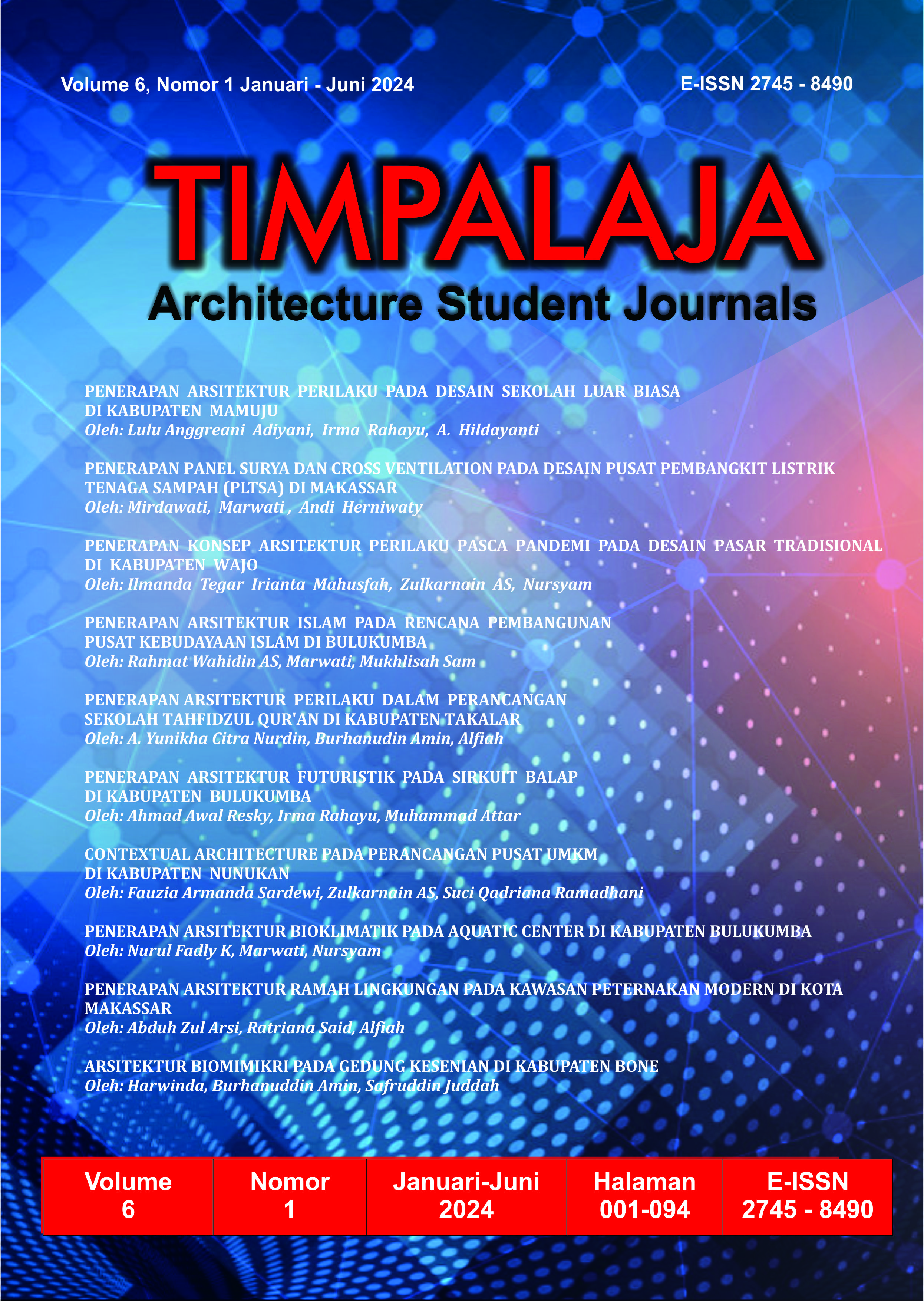Penerapan Arsitektur Bioklimatik pada Aquatic Center di Kabupaten Bulukumba
Abstract
This study aims to develop a bioclimatic design framework for the Pantai Alam Aquatic Center in Bulukumba Regency, Indonesia, tailored to the local humid climate. Bioclimatic architecture, which integrates climatic data and environmental considerations into building design, is employed to enhance energy efficiency and user comfort. This design includes the use of natural ventilation, natural lighting, and local materials, proven to be effective in creating energy-efficient and sustainable buildings. Through literature analysis and case studies, this research demonstrates that the application of bioclimatic principles can reduce energy consumption and improve thermal comfort. The findings underscore the importance of climate considerations in architectural design, especially in tropical regions. The conclusion of this study is that bioclimatic design is not only relevant but also critical for the development of sustainable and climate-adaptive public facilities. Further research is needed to monitor long-term performance and apply it to other building types. This project provides a model that can be adapted for public facilities in other tropical regions, promoting more environmentally friendly design practices.
References
Badan Standardisasi Nasional. (1992). SK SNI T-25-1991-03: Tata Cara Perencanaan Teknik Bangunan Stadion. Yayasan LPMB.
Fathy, H. (1986). Natural energy and vernacular architecture: Principles and examples with reference to hot arid climates. University of Chicago Press.
FINA. (2016). FINA facilities rules (2016 ed.). https://www.fina.org/sites/default/files/fina_facilities_rules_-_2016.pdf
Givoni, B. (1998). Climate considerations in building and urban design. John Wiley & Sons.
Gut, P., & Ackerknecht, D. (1993). Climate responsive building: Appropriate building construction in tropical and subtropical regions. SKAT Foundation.
Hasan, W. (2017). Perencanaan Gedung Neurologi Dengan Pendekatan Arsitektur Bioklimatik [Unpublished bachelor's thesis]. Universitas Islam Negeri Alauddin Makassar.
Hyde, R. (2000). Climate responsive design: A study of buildings in moderate and hot humid climates. E & FN Spon.
Jones, D. L. (1998). Architecture and the environment: Bioclimatic building design. Laurence King Publishing.
Krishan, A., Baker, N., Yannas, S., & Szokolay, S. V. (2001). Climate responsive architecture: A design handbook for energy efficient buildings. Tata McGraw-Hill Education.
Lechner, N. (2014). Heating, cooling, lighting: Sustainable design methods for architects (4th ed.). John Wiley & Sons.
Neufert, E. (2002). Data Arsitek Jilid 2. Erlangga.
Olgyay, V. (1962). Design with climate: Bioclimatic approach to architectural regionalism. Princeton University Press.
Olgyay, V. (1963). Design with climate: Bioclimatic approach to architectural regionalism. Princeton University Press.
Salmon, C. (1999). Architectural design for tropical regions. John Wiley & Sons.
Satria. (2020, July). Porprov 2022, KONI Sulsel beri jatah 19 cabor dipertandingkan di Sinjai. Insting Jurnalis.Com. https://www.instingjurnalis.com/2020/07/porprov-2022-koni-sulsel-beri-jatah-19-cabor-dipertandingkan-di-sinjai.html?m=1
Suaedy. (2019, January 1). Warga Serbu Obyek Wisata Lembah Biru di Desa Palambarae. Matarakyatmu.Com. https://matarakyatmu.com/2019/01/01/warga-serbu-obyek-wisata-lembah-biru-di-desa-palambarae/
Susanto, E. (2014). Pembelajaran Akuatik Prasekolah: Mengenalkan Olahraga Air Sejak Dini. UNY Press.
Yeang, K. (2006). Ecodesign: A manual for ecological design. Wiley-Academy.
Copyright (c) 2024 Nurul Fadly, Marwati, Nursyam

This work is licensed under a Creative Commons Attribution-ShareAlike 4.0 International License.
By submitting your manuscript to our journal, you are following Copyright and License







